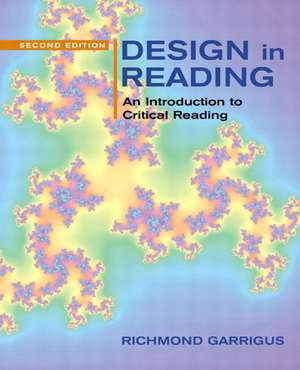Design in Reading: An Introduction to Critical Reading
Autor Richmond Garrigusen Limba Engleză Paperback – 30 iun 2002
Intended for the advanced reading course, "DESIGN IN READING " focuses heavily on purpose, inference, and critical reading. Its coverage of organizational patterns is second to none. After a review of the basics of critical reading--including main idea and supporting details-readers practice recognizing and mapping organizational patterns. Contextual vocabulary coverage is included throughout the book. Paragraphs and short passages used in examples and exercises are drawn from contemporary sources, as well as college textbooks from across the disciplines. The book uses pattern mapping throughout as a heuristic to help readers understand the various organizational structures that authors employ. Integrated throughout the book is instruction on higher-level critical thinking skills, such as drawing inferences, evaluating evidence, recognizing propaganda and bias, and identifying logical fallacies. For those interested in developing their reading skills.
Preț: 810.79 lei
Preț vechi: 1052.97 lei
-23% Nou
155.14€ • 162.42$ • 128.37£
Carte indisponibilă temporar
Specificații
ISBN-10: 0321096304
Pagini: 576
Dimensiuni: 191 x 237 x 27 mm
Greutate: 0.9 kg
Ediția:2Nouă
Editura: Pearson
Locul publicării:New York, United States
Descriere
After a review of the basics of critical reading--including main idea and supporting details--students practice recognizing and mapping organizational patterns. Contextual vocabulary coverage is included throughout the text. Both textbook readings and non-textbook readings are included.
Cuprins
Preface.
To the Student.
Introduction: Joining the Academic Dialogue.
I. READING FOR INFORMATION.
1. Responding to Factual Information.
2. Recognizing Important Information.
3. Making Inferences: Context Vocabulary and Implied Main Ideas.
4. Reading for Structure: The Organization of Ideas.
5. The Reader's Voice: Summary, Paraphrase, and Active Reading Strategies.
II. FROM INFORMATION TO PROOF.
6. Evaluating What We Think: Facts, Opinions, and Beliefs.
7. Assessing Qualities and Functions: Description and Support.
8. Recognizing the Order of Events: Time Sequence.
9. Seeing Connections in Events: Cause and Effect.
10. Grouping and Dividing: Classification and Whole/Part Analysis.
11. Recognizing Similarities and Differences: Comparison and Contrast.
III. PERSUASION INTO ACTION.
12. Determining What Needs to Be Done: Problems and Solution.
13. Arguing over Issues: Opinions and Reasons.
14. Detecting Disinformation: Advertising, Manipulation, and Propaganda.
Caracteristici
- Paragraphs and short passages used in examples and exercises are drawn from contemporary sources, as well as from college textbooks from across the disciplines.
- Uses pattern mapping throughout as an heuristic to help students understand the various organizational structures that authors employ.
- Vocabulary is taught in context. Questions follow many of the readings and frequent exercises direct students to create sentences of their own with new words that they encounter. The author also teaches word parts throughout Part II of the text, providing a core of high-frequency prefixes and roots.
- Integrates instruction on higher-level critical thinking skills such as drawing inferences, evaluating evidence, recognizing propaganda and bias, and identifying logical fallacies.
- Unique “Reading Portfolio” assignments provide opportunities for ongoing student reading and writing activity throughout the course.
Caracteristici noi
- NEW! More on the basics. The first part of the text now has five chapters (as opposed to four) on the basics of effective reading. There is extended coverage of topic, main idea, supporting details, patterns of organization, inference, and purpose and tone
- NEW! More exercises. The author has added many new exercises, in both subjective and objective format. The second edition is perfed to allow for ease of use. Multiple-choice and true/false questions allow students' work to be easily graded.
- NEW! More textbook excerpts. The author has added a wealth of textbook excerpts from across the disciplines.
- NEW! Extended vocabulary coverage. In addition to coverage of Word Parts throughout each chapter in Part II, all chapters now offer words-in-context vocabulary exercises with each reading.
